SLVSAB3I May 2010 – January 2016 DRV8832
PRODUCTION DATA.
- 1 Features
- 2 Applications
- 3 Description
- 4 Revision History
- 5 Pin Configuration and Functions
- 6 Specifications
- 7 Detailed Description
- 8 Application and Implementation
- 9 Power Supply Recommendations
- 10Layout
- 11Device and Documentation Support
- 12Mechanical, Packaging, and Orderable Information
Package Options
Mechanical Data (Package|Pins)
Thermal pad, mechanical data (Package|Pins)
Orderable Information
10 Layout
10.1 Layout Guidelines
The VCC pin should be bypassed to GND using low-ESR ceramic bypass capacitors with a recommended value of 0.1-μF rated for VCC. This capacitor should be placed as close to the VCC pin as possible with a thick trace or ground plane connection to the device GND pin.
The VCC pin must be bypassed to ground using an appropriate bulk capacitor. This component may be an electrolytic and should be located close to the DRV8832.
10.2 Layout Example
 Figure 16. Recommended Layout
Figure 16. Recommended Layout
10.3 Thermal Considerations
The DRV8832 has thermal shutdown (TSD) as described Thermal Shutdown (TSD). If the die temperature exceeds approximately 160°C, the device will be disabled until the temperature drops to a safe level.
Any tendency of the device to enter TSD is an indication of either excessive power dissipation, insufficient heatsinking, or too high an ambient temperature.
10.3.1 Power Dissipation
The power dissipation of the DRV8832 is a function of RMS motor current and the each output’s FET resistance (RDS(ON)).
For this example, the ambient temperature is 35°C, and the junction temperature reaches 65°C. At 65°C, the sum of RDS(ON) is about 1 Ω. With an example motor current of 0.8 A, the dissipated power in the form of heat will be 0.8 A2 × 1 Ω = 0.64 W.
The temperature that the DRV8832 reaches will depend on the thermal resistance to the air and PCB. It is important to solder the device PowerPAD to the PCB ground plane, with vias to the top and bottom board layers, dissipate heat into the PCB and reduce the device temperature. In the example used here, the DRV8832 had an effective thermal resistance RθJA of 47°C/W, and:
10.3.2 Heatsinking
The PowerPAD™ package uses an exposed pad to remove heat from the device. For proper operation, this pad must be thermally connected to copper on the PCB to dissipate heat. On a multi-layer PCB with a ground plane, this can be accomplished by adding a number of vias to connect the thermal pad to the ground plane. On PCBs without internal planes, copper area can be added on either side of the PCB to dissipate heat. If the copper area is on the opposite side of the PCB from the device, thermal vias are used to transfer the heat between top and bottom layers.
For details about how to design the PCB, refer to TI application report SLMA002, PowerPAD™ Thermally Enhanced Package and TI application brief SLMA004, PowerPAD™ Made Easy, available at www.ti.com.
In general, the more copper area that can be provided, the more power can be dissipated.